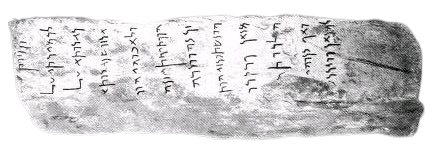Aramaic is a Semitic language related to Arabic,Hebrew,Amharic,Tigrinia and Akkadian the oldest Semitic language we know,more closely related to Hebrew.
During its' existence it has gone through many phases.It was never a uniform language but had many dialects influenced by various languages.Aramaic is still spoken today in small Aramaic speaking enclaves in the Middle East.These people speak the so-called Neo-Aramaic languages.
There is a lot of confusion all over the internet as to what Aramaic is with people posting links with e.g. the Lord's Prayer in Aramaic in the language of Jesus Christ as they claim. That is very wrong which I explain in my 'Aramaic monolith' article.
It was originally the native tongue of the Arameans-a Semitic people native to northern Syria.The Arameans lived divided in small kingdoms which disappeared rather early in history in what is now modern-day Syria and Mesopotamia.
In contrast,their language had a different fate. Aramaic became the language of trade and culture all over the Middle East reaching Greece and even India.It was adopted by many other non-Aramean Semitic peoples,like the Akkadians (Assyrians and Banylonians),the Jews and the Chaldeans.
It was originally the native tongue of the Arameans-a Semitic people native to northern Syria.The Arameans lived divided in small kingdoms which disappeared rather early in history in what is now modern-day Syria and Mesopotamia.
Two great empires used it as their second major language-first the Akkadian Empire adopted it as an official language along with Akkadian which was subsequently completely supplanted by Aramaic.Then the Persian Achaemenid Empire followed suit with Imperial Aramaic. Thus Aramaic became the lingua franca of the so-called Fertile Crescent.
Jesus Christ's native tongue
Jesus Christ himself spoke Aramaic as a first language. His native dialect was Galilean Aramaic, an obscure dialect of the Western Aramaic branch which is currently being reconstructed.
This dialect was heavily influenced by Greek and it seems that it might have been the dialect of Hellenized Jews.
Today the sole survivor of the Western branch is the dialect of Maalula, a village in South-Western Syria.
A later version of Aramaic, Syriac, became a vehicle of Syriac Christianity.
A later version of Aramaic, Syriac, became a vehicle of Syriac Christianity.
Aramaic's popularity in the region was disrupted by the conquests of Alexander the Great replaced by Greek as a common language.
Aramaic's legacy ended with the rise of another Semitic language,Arabic, and the expansion of Islam in the region. Arabic eventually supplanted Aramaic almost completely.
 |
| Aramaic in the Fertile Crescent Aramaic-1 A.D (orange) Syriac-1000 A.D.(yellow) Syriac Neo-Aramaic dialects today (green) |
It can be rougly divided into these periods:
- early Aramaic
- Imperial Aramaic
- Biblical Aramaic
- Syriac
- Neo-aramaic languages like Assyrian Neo-Aramaic and Turoyo, the most important ones in terms of numbers of speakers.

